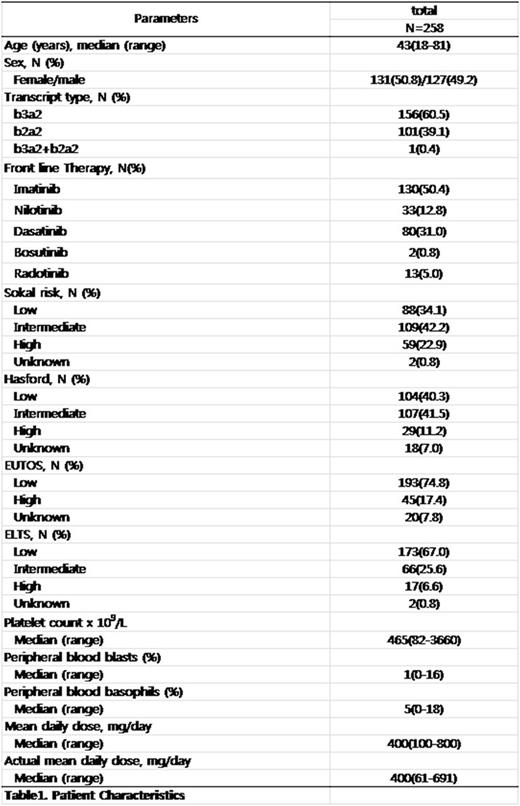Abstract
Background The early molecular response (EMR) by tyrosine kinase inhibitors (TKIs) is important to predict optimal response and survival in chronic phase chronic myeloid leukemia (CML-CP). However, EMR achievement can be affected by various clinical factors such as dose intensity, adverse events, blood level and risk scores. However, innate intrinsic sensitivity to TKIs of CML clones has not been considered.
Aims To define the optimal molecular response at early time point of treatment initiation with minimal dose interruption, we identified the optimal BCR-ABL1 transcript level measured at 4 weeks after TKI initiation and assessed the clinical impact.
Methods In this single center study, 258 newly diagnosed CML-CP patients were treated with various TKIs (130 imatinib and 128 second generation TKIs; 80 dasatinib, 33 nilotinib, 13 radotinib, and 2 bosutinib) and BCR-ABL1 transcript level were analyzed at 4 weeks (28 + 3 days) after frontline TKI initiation.
All of patients had e13a2 or e14a2 transcript and a receiver operating characteristic (ROC) curve from BCR-ABL1 transcript level on Day+28 was calculated to predict EMR at 3 months and major molecular response (MMR) at specific timepoints. The results of qRT-PCR were analyzed with at least 4.5-log sensitivity in the central laboratory (Leukemia Research Institute, The Catholic University of Korea, Seoul, Korea).
Results Median age was 43 years (18-81 years) and 127 patients were male (Table 1). At 4 weeks, the cut-off values of BCR-ABL1 transcript for achieving 12 month-MMR was 40.89% (very early molecular response; VEMR, P < 0.0001) by ROC curve analysis. One hundred thirty four patients achieving VEMR (<40.89% at 4 weeks) had significantly higher 5-year probabilities of Event-free survival (6.4% vs 13.4 %; P=0.021), cumulative incidence of complete cytogenetic response (89.5% vs 76.8 %; P=0.0001), and complete molecular response (25% vs 11 %; P=0.032) than no VEMR patients. Various predictive factors for achieving VEMR including age, sex, risk score, initial WBC, basophils, splenomegaly, baseline BCR-ABL1 transcript level were analyzed and the data will be presented.
Conclusions The very early molecular response defined on the basis of the BCR-ABL1 transcript level measured at 4 weeks of TKI treatment is important for the prediction of long-term responses and survivals. As it also allows for the prediction of CMR, VEMR can be used as one of the important tools to select candidates for treatment free remission.
No relevant conflicts of interest to declare.
Author notes
Asterisk with author names denotes non-ASH members.


